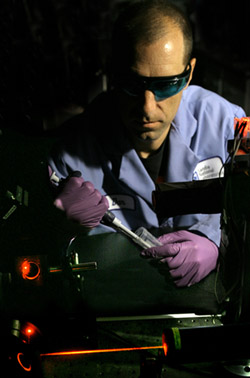NEWS RELEASES
FOR IMMEDIATE RELEASE
September 26, 2007
Sandia researchers to develop portable microfluidic platform for rapid detection of biotoxins

Sandia biochemist Dan Throckmorton prepares to add a sample to the prototype diagnostic device. After Dan adds the sample, computer-controlled electronics direct a series of sample analysis steps. Laser-induced fluorescence is used for highly sensitive detection of assay products. The final diagnostic device will feature a miniaturized, portable fluorescence detector.(Photo by Dino Vournas). Download 300dpi JPEG
(Media are welcome to download/publish this image with related news stories.)
LIVERMORE, CALIF. —Of all the threat scenarios facing emergency responders around the country, the release and spread of a dangerous biotoxin in a large public space is one of the most troubling.
The reason is simple. Though early diagnosis of biotoxin exposure is important for consequence mitigation and the key to saving lives, no current method exists for the quick, efficient detection of such poisonous agents.
That could all change one day soon, as researchers at Sandia National Laboratories in California have secured funding from the National Institute of Allergy and Infectious Diseases (NIAID) to design and engineer a small, portable microfluidic device that will offer rapid detection of biotoxin exposure in humans. In addition to speed, the device promises to offer high sensitivity, the capability to detect both presymptomatic and symptomatic markers, and ease-of-use.
The NIAID, part of the National Institutes of Health (NIH), has committed $3.2 million to the five-year project.
The effort is being undertaken in collaboration with Prof. B.R. Singh at the University of Massachusetts at Dartmouth and Steve Binder at Bio-Rad Laboratories.
Sandia is a National Nuclear Security Administration (NNSA) laboratory.
Device designed for point-of-care and point-of-incident settings
Instead of sending those suspected of being infected with a biotoxin – spectators at a sporting event who have been contaminated by a terrorist release, for example – to a medical facility where lab results could take days or weeks, Sandia’s Anup Singh says a lightweight, portable device would allow on-site emergency personnel to draw blood samples and make a rapid determination as to the degree of exposure. Those in need of treatment can then be monitored, and countermeasures can be immediately executed at the facility to mitigate further damage.
“It could be a fireman, a paramedic, or simply a primary care practitioner who might use this device one day,” says Singh, a chemical engineer at Sandia who will serve as the project’s principal investigator. The only stipulation, he says, is that the device’s end user will need to be authorized and trained in drawing blood, though that could change eventually. “In the not-so-distant future, a more accessible and readily available specimen such as saliva might be able to diagnose toxins,” he says.
Currently, says Singh, the technology to quickly test individuals for biotoxin exposure does not exist. Those suspected of being intoxicated must give blood samples at a medical facility and wait for laboratory analysis.
Singh says those toxins able to be detected by the device will include botulinum toxin, SEB (Staphylococcal Enterotoxin B), shiga toxins, Clostridium perfringens epsilon toxin,and others.
Builds upon success of saliva-based diagnostics project
The Sandia-led project – which will include collaborations with the University of Massachusetts and Bio-Rad Laboratories – builds upon the success of the lab’s well-known “spit project,” a program also funded by the NIH. That project could allow dentists to one day quickly test patients for gum disease and other afflictions via saliva samples.
Anson Hatch, a Sandia bioengineer and a microfluidic expert, will lead the microfluidic assay development effort. The system will incorporate microfluidic methods developed by Hatch and others at Sandia that facilitate hands-free analysis by integrating sample pretreatment with electrophoretic immunoassays that quickly measure analyte concentrations in blood. The self-contained device will consist of miniaturized electronics, optical elements, fluid-handling components, data acquisition software, and a user interface.
The technology, device, and methods, says Singh, can also be extended to detection of biomarkers of other systemic diseases and conditions such as cancer and cardiovascular disease.
Sandia is a multiprogram laboratory operated by Sandia Corporation, a Lockheed Martin company, for the U.S. Department of Energy’s National Nuclear Security Administration. With main facilities in Albuquerque, N.M., and Livermore, Calif., Sandia has major R&D responsibilities in national security, energy and environmental technologies, and economic competitiveness.
Sandia news media contact: Mike Janes , mejanes@sandia.gov, (925)294-2447